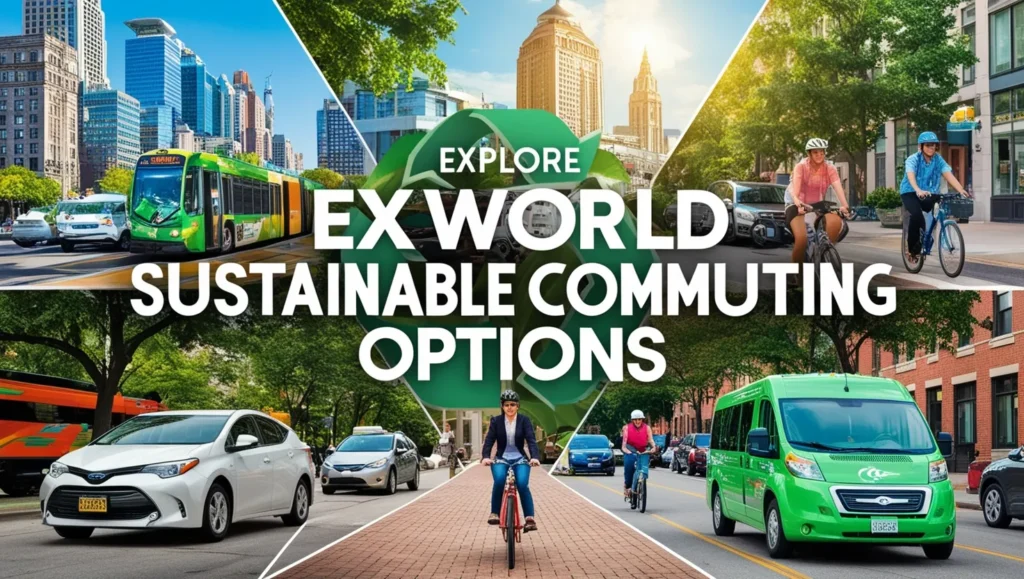Sustainable Commuting Options for Urban Dwellers
Sustainable Commuting Options for Urban Dwellers comes with its unique set of challenges, especially when it comes to commuting. Traffic congestion, environmental pollution, and rising fuel costs make traditional commuting options less viable and more frustrating. Sustainable commuting offers an eco-friendly and efficient way for urban dwellers to navigate cities while reducing their carbon footprint and improving their quality of life.
Here’s an in-depth look at sustainable commuting options and how they can transform urban transportation.
1. Walking: The Most Eco-Friendly Option
Walking is the simplest and most sustainable way to commute, especially for short distances. Sustainable Commuting Options for Urban Dwellers
- Health Benefits: Walking improves cardiovascular health, boosts mood, and helps maintain a healthy weight.
- Environmental Impact: It’s a zero-emission mode of transportation that requires no fossil fuels.
- Cost-Effective: There are no costs involved except a good pair of walking shoes.
2. Cycling: Speed and Sustainability Combined
Cycling is another excellent option for eco-conscious commuters.
- Reduced Carbon Footprint: Bicycles produce no emissions and help decrease air pollution.
- Efficiency: Cycling can often be faster than cars during peak traffic hours.
- Accessibility: Many cities now offer bike-sharing programs and dedicated bike lanes for safe commuting.
3. Public Transportation: A Collective Effort
Buses, trains, and trams are critical components of sustainable urban commuting.
- Mass Efficiency: Public transport can carry dozens or even hundreds of passengers, reducing the number of individual vehicles on the road.
- Cost Savings: Monthly transit passes are generally more affordable than car maintenance and fuel.
- Reduced Congestion: Fewer cars mean smoother traffic flow in urban areas.
4. Carpooling and Ridesharing
Carpooling and ridesharing platforms are growing in popularity due to their convenience and cost-sharing benefits.
- Shared Costs: Fuel and tolls are divided among passengers, making it more economical.
- Environmental Benefits: Fewer cars on the road lead to lower greenhouse gas emissions.
- Flexibility: Apps and online platforms make organizing carpools simple and accessible.
5. Electric and Hybrid Vehicles
For those who need personal vehicles, switching to electric or hybrid cars is a sustainable choice.
- Lower Emissions: Electric vehicles (EVs) produce zero emissions, and hybrids use fuel more efficiently.
- Government Incentives: Many countries offer tax breaks and subsidies for EV purchases.
- Charging Infrastructure: Increasingly, urban areas are investing in EV charging stations for convenience.
6. Workplace and Lifestyle Adjustments
Adopting remote work or flexible schedules can also contribute to sustainable commuting.
- Remote Work: Telecommuting eliminates the need for daily travel altogether.
- Flexible Hours: Avoiding peak traffic hours can reduce time spent idling in congestion, saving fuel and lowering emissions.
- Micromobility Options: Scooters and e-bikes provide alternatives for shorter commutes while being environmentally friendly.
7. Advocating for Sustainable Urban Planning
Urban dwellers can also push for policies and infrastructure that support sustainable commuting.
- Green Infrastructure: Advocating for more bike lanes, pedestrian paths, and green spaces encourages eco-friendly travel.
- Investment in Public Transit: Supporting expanded and efficient public transportation systems benefits everyone.
- Community Efforts: Join or form local initiatives to promote car-free days and other sustainability-focused events.
8. Leveraging Technology for Sustainable Commuting
Apps and digital platforms make sustainable commuting easier than ever.
- Navigation Tools: Apps like Google Maps suggest walking, cycling, and public transit options for trips.
- Carpooling Platforms: Services like BlaBlaCar and Lyft Line connect commuters traveling in the same direction.
- Bike-Sharing Programs: Urban bike-sharing networks provide affordable access to bicycles for short-term use.
Benefits of Sustainable Commuting
Sustainable Commuting Options for Urban Dwellers
- Environmental Impact: Reducing emissions helps combat climate change and improves air quality in cities.
- Economic Savings: Walking, cycling, and public transport are far more affordable than maintaining a car.
- Health Advantages: Active modes of commuting promote physical activity, reducing the risk of lifestyle diseases.
- Community Engagement: Using shared resources fosters a sense of community and cooperation among urban residents.
Final Thoughts
Sustainable Commuting Options for Urban Dwellerss not only a personal choice but a collective responsibility that benefits individuals and society as a whole. By walking, cycling, using public transportation, or switching to electric vehicles, urban dwellers can significantly reduce their environmental impact while enjoying cost savings and health benefits. With a combination of personal commitment and supportive urban infrastructure, sustainable commuting can redefine the way cities operate and thrive.
Start exploring these options today and be a part of the movement toward greener, more efficient urban living! Sustainable Commuting Options for Urban Dwellers

